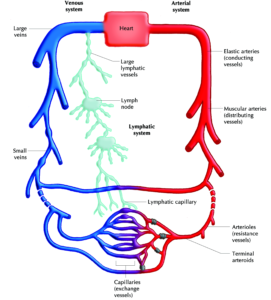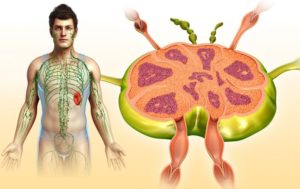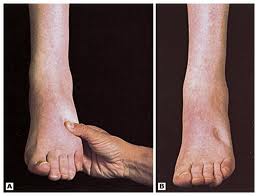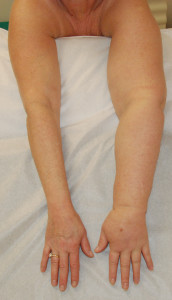The term “swelling” is used to describe an enlargement of a body part and can be used to describe edema, as well as lymphedema. While the initial causes for the formation of the swelling are different, both involve the accumulation of fluid in the soft tissues of the skin due to some form of insufficiency of the lymphatic system. However, edema and lymphedema are clearly not the same and require different treatment approaches.
Function of the Lymphatic System
The lymphatic system is part of the circulatory system and consists of a network of lymphatic vessels that carry a clear fluid called lymph. The lymphatic system has multiple interrelated functions:
- Collection and transport of fluids (water) from the tissues of the body back to the venous system (fluid homeostasis),
- Absorption and transportation of fatty acids from the digestive system, and
- Immune response – lymph nodes and other lymphatic organs filter the lymph to remove microorganisms and other foreign particles.

Components of Lymph Fluid
Once the fluid from the tissues enters the lymphatic system, it is called lymph (from Latin lympha = water). Lymph fluid is clear and transparent, with the exception of the lymph fluid found in lymph vessels draining the intestinal system; fatty acids absorbed by intestinal lymphatics produce a cloudy or milky appearance of the lymph fluid. In addition to the water and fatty acids, lymph fluid contains proteins and cellular components.
The main component of lymph fluid is water, which flows through the lymphatic system and plays an essential role in the body’s fluid management. The fluid, which is filtered out through the walls of the blood capillaries, is located between the cells in all body tissues and enters the  lymphatic system via the smallest lymph vessels, the lymph capillaries. This lymphatic fluid is then transported by progressively larger lymph vessels (collectors) to lymph nodes, where substances are removed from the lymph fluid by tissue lymphocytes, and circulating lymphocytes are added to the fluid. Following the passage through lymph nodes, the lymph fluid ultimately enters into the right or the left subclavian vein, where it mixes with the central venous blood. Throughout the course of a day, between 70 to 100 fluid ounces (2-3 liters) of water are returned by the lymphatic system back into the venous circulation.
lymphatic system via the smallest lymph vessels, the lymph capillaries. This lymphatic fluid is then transported by progressively larger lymph vessels (collectors) to lymph nodes, where substances are removed from the lymph fluid by tissue lymphocytes, and circulating lymphocytes are added to the fluid. Following the passage through lymph nodes, the lymph fluid ultimately enters into the right or the left subclavian vein, where it mixes with the central venous blood. Throughout the course of a day, between 70 to 100 fluid ounces (2-3 liters) of water are returned by the lymphatic system back into the venous circulation.
Transport Capacity of the Lymphatic System
The amount of lymph fluid the body produces varies; increased activity or certain pathologies, like venous insufficiencies, increases the amount of lymph fluid the lymphatic system is responsible to transport. As long as the lymphatic system is healthy and sufficient, it will be able to cope with the increased amount of fluid, due to its transport capacity, which has a built in functional reserve. The transport capacity is the maximum amount of fluid the lymphatic system can handle. In an undisrupted, healthy lymphatic system, the transport capacity exceeds the normal amount of lymph fluid by a factor of almost 10, which allows the lymphatic system to react to an increased volume of water and proteins by increasing its activity and cope with the additional volume.
Insufficiencies of the Lymphatic System
An insufficiency is present if the transport capacity of the lymphatic system is smaller than the volume of lymphatic fluid; there are three forms of insufficiency, which can result in either edema or lymphedema: dynamic, mechanical, or combined insufficiency.
Dynamic Insufficiency: This is the most common insufficiency, also known as high-volume  insufficiency. In this case, the volume of water (sometimes of protein and water) exceeds the transport capacity of the healthy lymphatic system, which results in edema. Edema is a swelling caused by the accumulation of abnormally large amounts of fluid in the inter-cellular tissue spaces of the body, which is visible and/or palpable (pitting). It is a symptom rather than a disease or disorder, and may be caused by cardiac insufficiency, immobility, chronic venous insufficiency (stage I and II), pregnancy, and other factors.
insufficiency. In this case, the volume of water (sometimes of protein and water) exceeds the transport capacity of the healthy lymphatic system, which results in edema. Edema is a swelling caused by the accumulation of abnormally large amounts of fluid in the inter-cellular tissue spaces of the body, which is visible and/or palpable (pitting). It is a symptom rather than a disease or disorder, and may be caused by cardiac insufficiency, immobility, chronic venous insufficiency (stage I and II), pregnancy, and other factors.
Prolonged dynamic insufficiency (e.g., months; the duration varies depending on the condition and severity) can cause secondary damage to the lymphatic system. The constant overload causes the lymph collectors working at their transport capacity over extended periods of time, possibly resulting in damage to the structure of lymph collectors (walls and valves). Secondary damage to the lymph collectors could cause a reduction in their transport capacity, which would exacerbate the situation.
To avoid secondary damage to the lymphatic system and the tissues, it is imperative to reduce the amount of lymphatic fluid as soon as possible. In localized edema, this can be achieved by elevation, exercise, and compression, as long as the overload is not caused by cardiac insufficiency, in which case compression therapy is contraindicated. In some instances, diuretics may be prescribed to reduce the edema.
Mechanical Insufficiency: This form, also known as low-volume insufficiency, is caused by a  reduction in the transport capacity of the lymphatic system due to surgery, radiation, trauma, or inflammation involving the lymphatic system. The impairment is so severe that the lymphatic system is unable to perform one of its basic functions, which is the removal of water and protein from the tissues, or to respond to an increase in the lymphatic load of water and protein. This will result in high-protein edema or lymphedema.
reduction in the transport capacity of the lymphatic system due to surgery, radiation, trauma, or inflammation involving the lymphatic system. The impairment is so severe that the lymphatic system is unable to perform one of its basic functions, which is the removal of water and protein from the tissues, or to respond to an increase in the lymphatic load of water and protein. This will result in high-protein edema or lymphedema.
Lymphedema, if left untreated, will lead to serious consequences. The stagnation of water, protein, and other waste products in the interstitial tissues may cause tissue damage. The stagnated protein-rich swelling causes increased tissue formation (fibrosis) and leads to a high susceptibility to infections (cellulitis).
To reduce lymphedema and to avoid further damage, it is imperative to treat this condition as soon as possible with complete decongestive therapy (CDT), which is the therapy of choice, and internationally recognized as the gold-standard for the treatment and management of lymphedema. Diuretics are not indicated to treat lymphedema.
Combined Insufficiency: In this case, the transport capacity of the lymphatic system is below its normal level, and in addition, the amount of lymph fluid is elevated. The maximum degree of this insufficiency is reached if the transport capacity is reduced below the level of normal lymphatic fluid (mechanical insufficiency), and simultaneously the volume of lymph fluid is greater than the transport capacity of a healthy lymphatic system (dynamic insufficiency). The combination of these insufficiencies may lead to severe tissue damage (necrosis) and chronic inflammation in the affected areas.
If a mechanical insufficiency is present and the lymphatic load of water, or protein and water increases, combined insufficiency will be the result.
To avoid the additional complication of a combined insufficiency in the presence of dynamic insufficiency, the primary goal is to reduce the lymphatic volume.
In lymphedema (mechanical insufficiency), the clinical goal is to reduce the interstitial swelling as soon as possible and to avoid an additional increase in lymphatic load. It is also important to understand that infection, trauma, and certain forms of exercise result in an increase in lymphatic fluid (as well as protein and cells), which may lead to combined insufficiency with further complications. To avoid this situation, it is necessary to provide patients affected by lymphedema with as much information as possible.
Dear Lymphedema Blog Reader – if you like the contents on this website, please help to keep it going. A great amount of work and research is necessary to provide you with up-to-date information on this site. Your donation supports these efforts and associated administrative costs. Surplus funds will be donated to Lymphedema/Lipedema-related charitable endeavors. Please donate using the “Donate Now” button on the right upper hand of this page – Thank You!
Join Lymphedema Guru, a Facebook page solely dedicated to inform about all things related to lymphedema – news, support groups, treatment centers, and much more


 Joachim Zuther, Lymphedema Specialist.
Joachim Zuther, Lymphedema Specialist. 

Really enjoyed this blog post, is there any way I can receive an email every time there is a fresh article?
Im massage Therapist, I would like to receive information
every time about Edema & Lymphedema. Thank You!!!
Please enter your email address on the top right corner of the website in order to receive a notification every time a new article is posted. You may also “like” the Lymphedema Guru Facebook page to receive daily updates on all things lymphedema.https://www.facebook.com/LymphedemaGuru